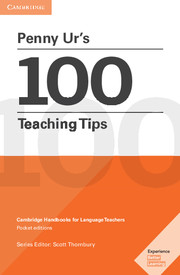Book contents
- Frontmatter
- Contents
- Why I Wrote this Book
- Beginning and Ending the Lesson
- The Coursebook
- Discipline
- Error Correction
- Games
- Grammar
- Group Work
- Heterogeneous (Mixed-Level) Classes
- Homework
- Interest
- Listening
- Pronunciation
- Reading Comprehension
- Speaking Activities
- Teacher Talk
- Testing and Assessment
- Vocabulary Teaching
- Writing
- P.S.
- Index
- Photo Acknowledgements
Grammar
Published online by Cambridge University Press: 17 November 2023
- Frontmatter
- Contents
- Why I Wrote this Book
- Beginning and Ending the Lesson
- The Coursebook
- Discipline
- Error Correction
- Games
- Grammar
- Group Work
- Heterogeneous (Mixed-Level) Classes
- Homework
- Interest
- Listening
- Pronunciation
- Reading Comprehension
- Speaking Activities
- Teacher Talk
- Testing and Assessment
- Vocabulary Teaching
- Writing
- P.S.
- Index
- Photo Acknowledgements
Summary
I’m definitely in favour of teaching grammar in most classes. The problem is how to do it effectively so that it doesn't take up too much time, doesn’t become boring, and helps students use the grammatical features to express themselves.
26 Keep explanations short
27 Use mother tongue to explain
28 Avoid grammatical terms
29 Get students to learn by heart
30 Get students to make meanings
26 Keep explanations short
The first time you explain a grammatical feature, make it short and simple: keep it to a ‘need to know’ basis.
What students need is to get the basic idea of how the grammar works in order to enable them to understand examples in context as soon as possible, and try using it themselves.
Note that there's a payoff between brevity and truth: the more true and accurate the rule you give, the more difficult and lengthy the explanation. So often it's worth sacrificing the fully accurate account in favour of keeping it short and simple. Give students a clear, easy and mostly reliable rule and leave any further detailed explanations for when they come across apparent exceptions.
For example, most other languages have only one word for much/many, so you need to explain the difference between these. But you don't have to get into complicated explanations of ‘countable’ and ‘uncountable’ nouns. All you need to say is that much goes with singular nouns and many with plural, which covers virtually all instances.
Some rules are so complicated and difficult to apply in real time that it’s best not even to try to explain them. For example, expression of future time: going to usually implies some kind of plan or intention whereas will expresses simple prediction. But who has time when talking about the future to stop and wonder how much planning is involved in any particular instance? So I usually tell beginner classes that both forms refer to the future, and leave it at that. Detailed explanations can wait for later: and often I’ve found I never need to give them, because the students acquire an intuitive feel for the distinction through lots of encounters with examples in context.
For more on this issue, see the reference below.
- Type
- Chapter
- Information
- Penny Ur's 100 Teaching TipsCambridge Handbooks for Language Teachers, pp. 31 - 36Publisher: Cambridge University PressPrint publication year: 2016



